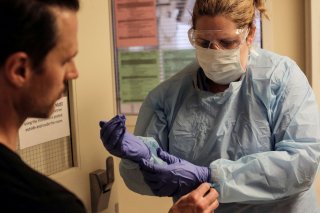Coronavirus: How Masks Present a Problem to People With Hearing Loss
Mask wearing and social distancing present a real problem for many people with hearing loss.
The Centers for Disease Control and Prevention has recommended that all Americans wear face coverings when in public. Hospitals across the country are assuming everyone who walks through the door is a potential COVID-19 case, so are requiring patients to wear a mask and come alone.
These changes pose potential communication problems for about 60 million Americans who are living with hearing loss, ranging from mild trouble to severe loss or deafness in one or both ears. The vast majority of people with hearing loss have never had a hearing test and do not use hearing aids, especially in populations affected by health disparities. For example, only an estimated 5% of Hispanic/Latino adults with hearing loss use hearing aids.
Along with my audiology and public health colleagues from the Hispanic Hearing Healthcare Access Coalition, we strongly recommend that communities take special measures to stay connected with the hard-of-hearing at this time. Mask wearing and social distancing present a real problem for many people with hearing loss.
Harder hearing
Human brains are designed to use visual cues, like watching one another’s lips move, to help understand speech. Wearing a mask eliminates this vital visual information.
Acoustically, face masks muffle speech. Donning a mask over a hearing aid or cochlear implant can be problematic or uncomfortable – causing some to remove their hearing devices.
The need to stay at least six feet apart for social distancing can also make hearing and understanding speech more difficult. As distance increases, sound levels decrease. Research shows that moving farther away makes it more challenging for people with hearing loss to focus their attention on understanding speech.
Research shows background noise in a hospital makes it difficult to hear, understand and absorb key information, with memory disrupted even if what was said in the moment was heard. After measuring sound levels in a Portland, Oregon Veterans hospital, researchers recorded background noise from medical and surgical wards then tested acutely ill patients. In the best-case scenario with low noise, hospitalized patients with mild to moderate hearing loss could recall only 58% of key words. This dropped to 30% recall at the highest levels of hospital noise tested. All these disruptions can have serious consequences.
People with hidden or undiagnosed hearing loss may now be revealed, as their coping strategies falter. In this new reality, those who are hard-of-hearing and deaf may be unable to access public health recommendations, learn about available services or make informed decisions about their own care when speech is only auditory. This is especially true for people in hospitals, nursing homes or quarantine, who may find themselves suddenly isolated without assistance from family or friends.
Enhancing communication
The good news is that simple, effective strategies can boost communication during this time of wearing masks and beyond.
Face each other at a safe distance of at least six feet. Maintaining eye contact enhances social connection and keeps attention focused on communication. Speak more slowly and with care to make it easier for listeners. Speakers often naturally try to compensate by projecting, but a more effective approach is to speak more clearly, with greater enunciation.
Ask others to repeat back what you said to confirm the message is being understood and not just heard. For health care providers, this “teach-back” strategy is essential to ensure understanding, whether the discussion is in-person or remote.
Real-time captioning can improve communication access in telehealth, virtual meetings and online education.
Ask the deaf or hard-of-hearing person, “How can I best communicate with you?” Try re-phrasing the information if the listener is having difficulty understanding your message. Write your message down or try speech-to-text if someone is having trouble hearing you.
Select quiet spaces with little background noise for improved listening. If available, use or make clear masks or face shields, which will help by restoring visual information in speech.
Seek out and offer multiple forms of communication, such as written text or real-time captioning and assistive technology. For those who use American Sign Language, qualified interpreters can be accessed through video relay. People with hearing loss or combined hearing and vision loss may want to bring a printed communication card along with them to the hospital. The Hearing Loss Association of America and National Association of the Deaf are sharing guidance for patients and providers.
Following these recommendations can empower people to communicate more effectively with the hard-of-hearing. While many things are out of control at this time, everyone can choose communication strategies that will help each other.
[You need to understand the coronavirus pandemic, and we can help. Read The Conversation’s newsletter.]
![]()
Nicole Marrone, Associate Professor in Speech, Language, and Hearing Sciences, University of Arizona
This article is republished from The Conversation under a Creative Commons license. Read the original article.
Image: Reuters



